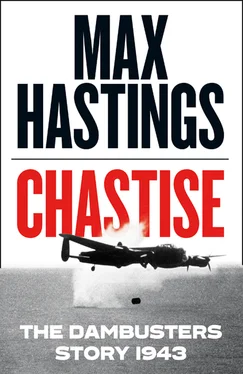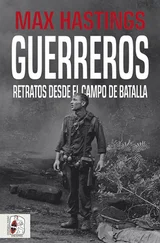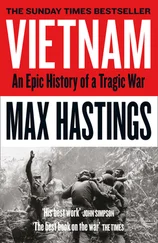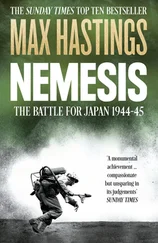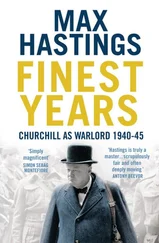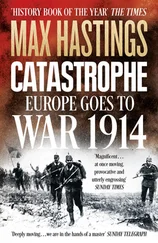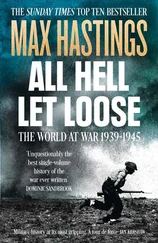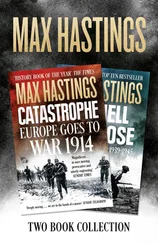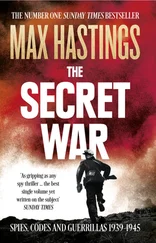Yet in the twenty-first century it also seems essential to confront – as many past British writers have been reluctant to confront – the enormity of the horror that the unthinking fliers unleashed upon a host of innocents. A Norwegian Resistance hero, Knut Lier-Hansen, wrote words in 1948 that linger in my mind whenever I compose narratives of conflict: ‘Though wars can bring adventures which stir the heart, the true nature of war is composed of innumerable personal tragedies, of grief, waste and sacrifice, wholly evil and not redeemed by glory.’ We shall consider below whether the extraordinary tale of Operation Chastise – its impact upon the Second World War set against its human consequences – is ‘redeemed by glory’.
MAX HASTINGS
Chilton Foliat, West Berkshire, and Datai, Langkawi, Malaysia
May 2019
Let us begin this story where he began it: in the cockpit of an Avro Lancaster heavy bomber, callsign G-George, forging through the darkness towards Germany on the night of 16 May 1943, amid the roar of four Rolls-Royce Merlin engines that drowned out conversation save over the intercom. ‘The moon was full; everywhere its pleasant, watery haze spread over the peaceful English countryside, rendering it colourless. But there is not much colour in Lincolnshire anyway. The city of Lincoln was silent – that city which so many bomber boys know so well, a city full of homely people.’ Guy Gibson’s Enemy Coast Ahead , written in 1944, a few months before his death, is one of the great wartime warriors’ memoirs, despite its cavalier attitude to facts and dates. Those who edited the typescript for publication after its author perished softened harshnesses: for instance, Gibson originally characterised Lincoln as ‘full of dull, unimaginative people’, perhaps because his own experiences were beyond their imaginations, and those of most of us.
The book reveals a sensitivity that few of the squadron commander’s men recognised in him, together with a consciousness of his own mortality, derived from completion of an astounding seventy-two previous bomber operations, together with ninety-nine sorties as pilot of a night-fighter. He describes the fate of an aircraft hit over Germany, plunging steeply out of the sky for an interminable minute, ‘then it is all over and you hit the ground. Petrol flames come soaring up into the sky, almost reaching to meet you as though to rocket your soul to heaven.’ He knew. Unlike some heroes who are bereft of fear, Gibson anticipated his own almost certain destiny. Only its hour remained to be fixed, and this May night seemed more plausible than most.
He was leading 617 Squadron of the RAF’s Bomber Command to unleash upon the dams of north-western Germany a revolutionary new weapon, requiring an attack at extreme low level. Nineteen crews were committed to Operation Chastise, and the eight proven in training to be most proficient now accompanied Gibson himself towards the Möhne. Off his port wingtip flew the dashing Australian Harold ‘Micky’ Martin in P-Popsie, while a few yards to starboard was ‘Hoppy’ Hopgood’s M-Mother, its pilot a twenty-one-year-old who still began his letters home ‘Dear Mummy’.
Gibson again: ‘We were off on a journey for which we had long waited, a journey that had been carefully planned, carefully trained for’ – only eight weeks, in truth, since inception, but such a span represented an eternity to very young men, crowding what should properly have been a lifetime’s experience into a fraction of a natural span: Gibson considered entitling the later memoir of his career as a bomber pilot Four Years Lifetime – ‘a mission which was going to do a lot of good if it succeeded’. The chiefs of the RAF had promised the aircrew of 617 Squadron that breaching the dams would inflict damage upon Germany’s war industries greater than any previously achieved by an air force.
Among the sharpest contrasts between the environment of twentieth-century war and that of twenty-first-century peace is colour. We live in a world of reds and whites, blues, silvers, oranges. Allied airmen bombing Europe in 1943 existed by day under sunshine and bright skies, then fought their battles in a universe that was darkened, shaded, shadowed, unless or until it erupted into flame. The undersides and flanks of night bombers were painted matt black; their upper surfaces disrupted foliage-greens and earth-browns. Once airborne, Gibson and his kin inhabited cramped, stunted workspaces, crowded with technology and control mechanisms, black or green save where paint had been worn away by human friction and hard usage to reveal streaks of dull metal.
He wrote: ‘The pilot sits on the left on a raised, comfortably padded seat … usually flies the thing with his left hand, resetting the gyro and other instruments with his right, but most pilots use both hands when over enemy territory or when the going is tough. You have to be quite strong to fly a Lancaster. The instruments sit winking. On the Sperry panel, or the blind-flying panel as bomber pilots call it, now and then a red light, indicating that some mechanism needs adjusting, will suddenly flash on … The pilot’s eyes constantly perform a circle from the repeater to the Air Speed Indicator, from the ASI to the horizon, from the horizon to the moon, from the moon to what he can see on the ground and then back to the repeater. No wonder they are red-rimmed when he returns.’
Gibson himself had much to be red-rimmed about. Since 1940, he had been almost continuously making war. Two months earlier he completed a tour as 106 Squadron’s commander, during which he flew its most hazardous operations. He was now among the most decorated pilots in the RAF, holding two Distinguished Service Orders, two Distinguished Flying Crosses. In the seven weeks since he began to form 617 Squadron he had grappled with relentless administrative and personnel problems; directed specialised crew training; raced between Scampton, Weybridge and Reculver to discuss the dam-busting bomb with its creator and to witness the mixed fortunes of its trials. He had flown low-level tests by day and night; hastened to and from the Grantham headquarters of 5 Group for tactical conferences; delivered the most important briefings of his life; and now, taken off for Germany in the dying light of a lovely English spring Sunday.
Exhaustion most conspicuously manifested itself in an inflamed foot condition which caused pain on the ground, worse in the air. In a conversation with Gibson that morning, the station medical officer felt unable to prescribe medication, lest it impair the pilot’s reflexes. Meanwhile Gibson’s three-year marriage to an older showgirl had become a poor thing. His only relaxation in weeks had been a snatched trip to a Grantham ‘flickhouse’ with a WAAF girlfriend to see Casablanca . Like a host of young men of all the nations engaged in the Second World War, he had aged years beyond the twenty-four cited in RAF records.
That night of 16 May, he wrote of himself and John Pulford, the flight-engineer on the folding seat beside him in the Lancaster’s ‘glass house’: ‘two silent figures, young, unbearded, new to the world yet full of skill, full of pride in their squadron, determined to do a good job and bring the ship home. A silent scene, whose only incidental music is provided by the background hiss of air and the hearty roar of four Merlin engines.’ He described Pulford as ‘a Londoner, a sincere and plodding type’. He embraced Fred ‘Spam’ Spafford, the bomb-aimer, as ‘a grand guy and many were the parties we had together’. His rear-gunner, Richard Trevor-Roper, silent in the remoteness of the tail, was ‘Eton, Oxford’, to which his pilot added that ‘Trev’ ‘was probably thinking what I was thinking. Was this the last time we would see England?’
Читать дальше
